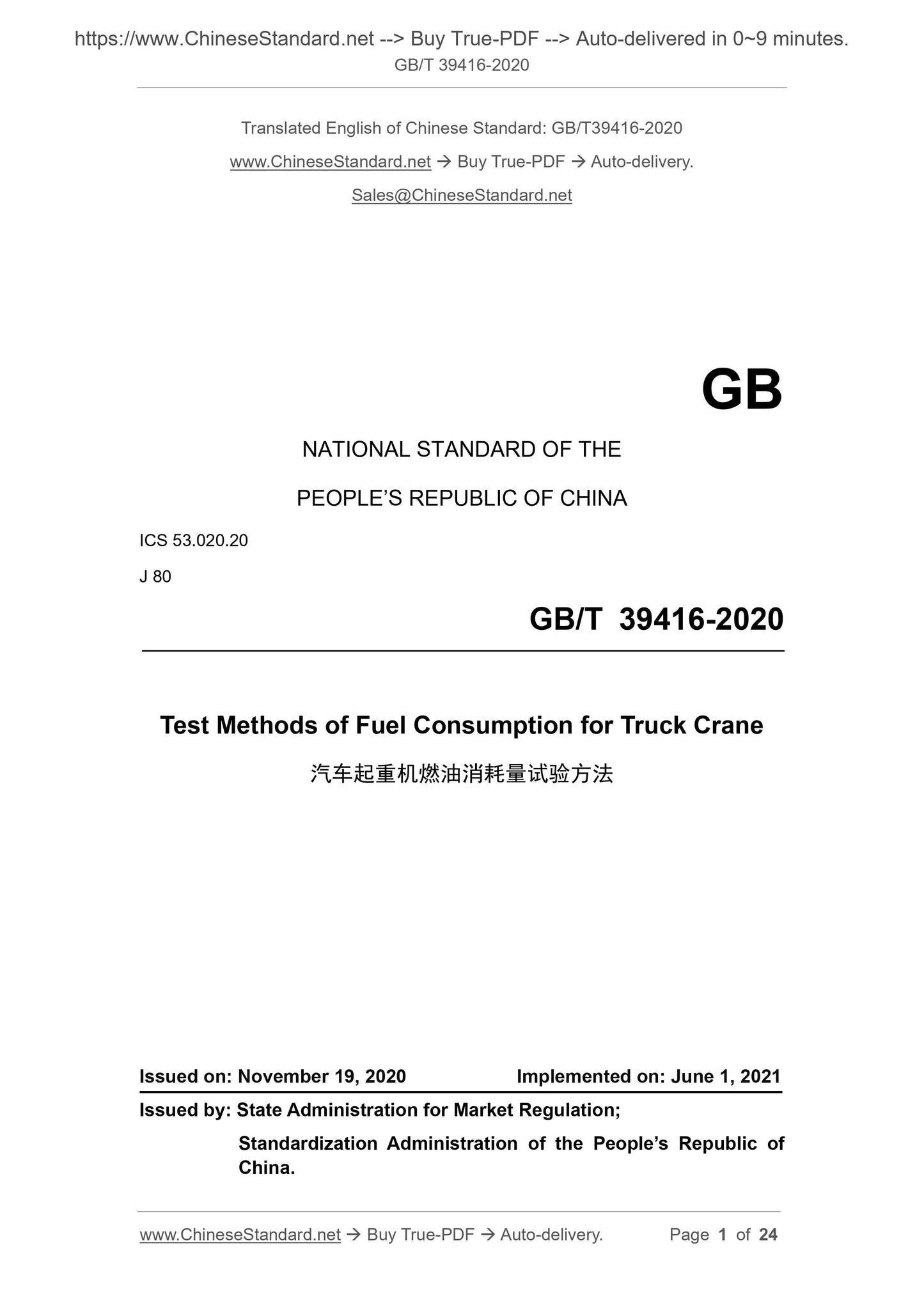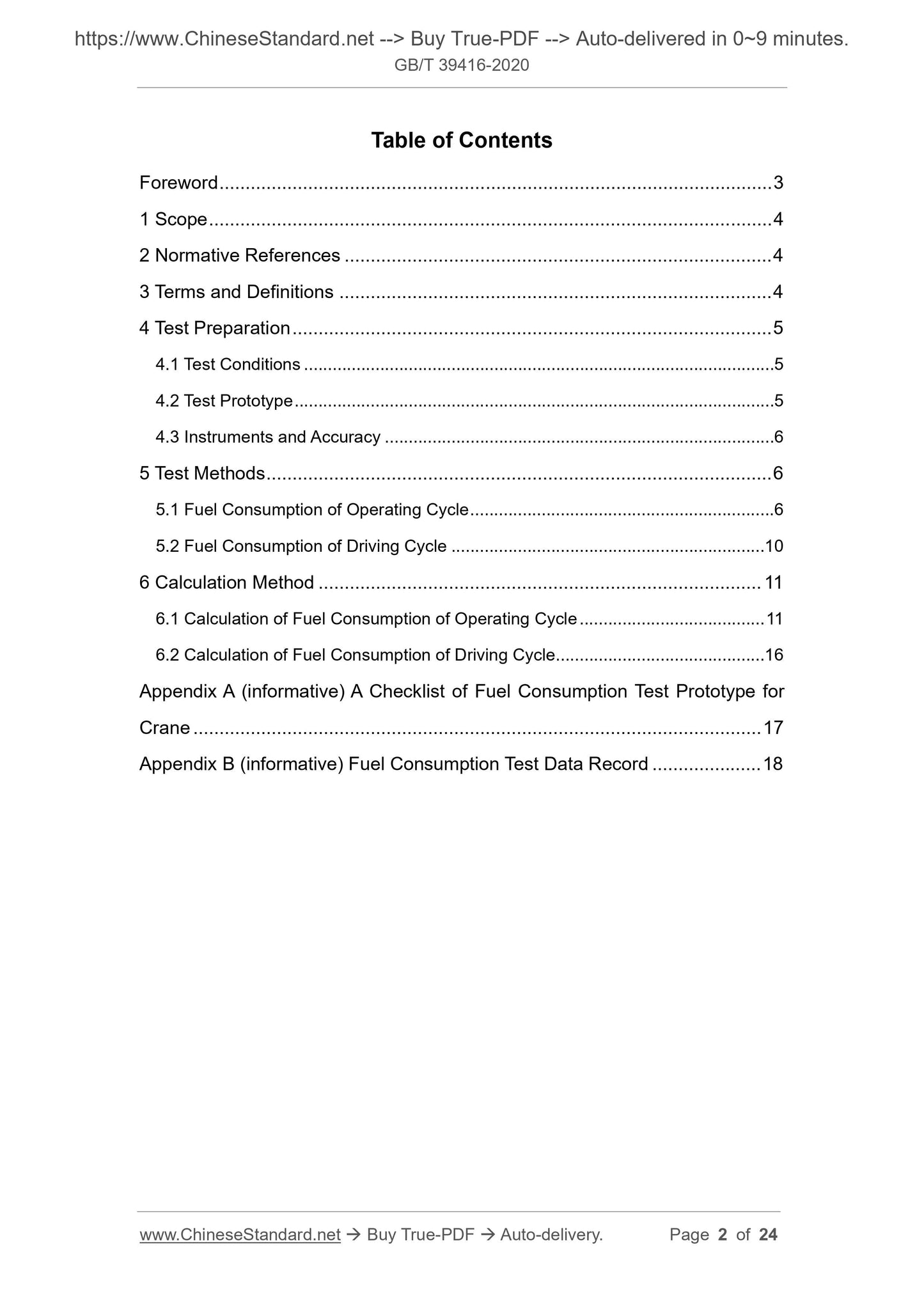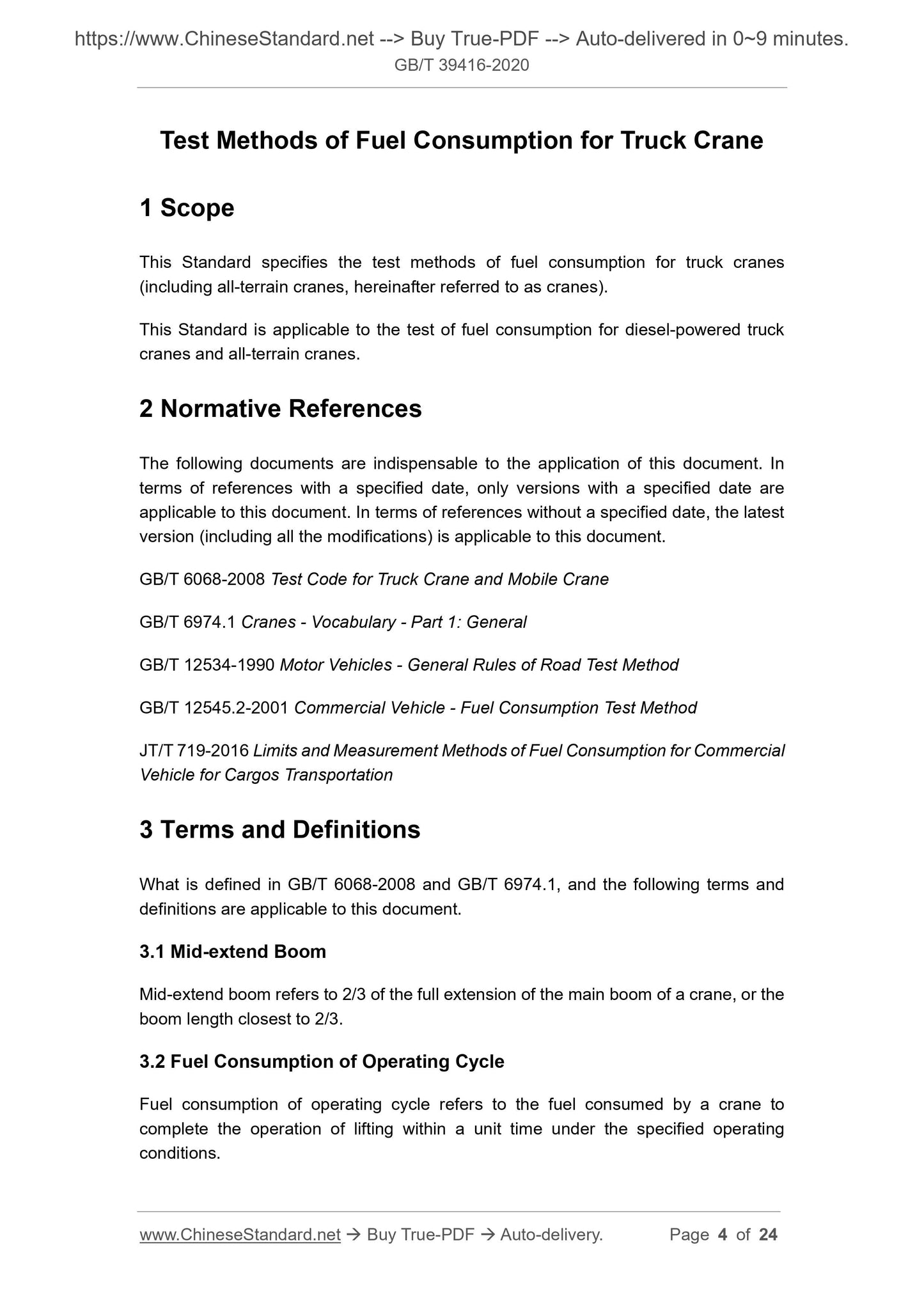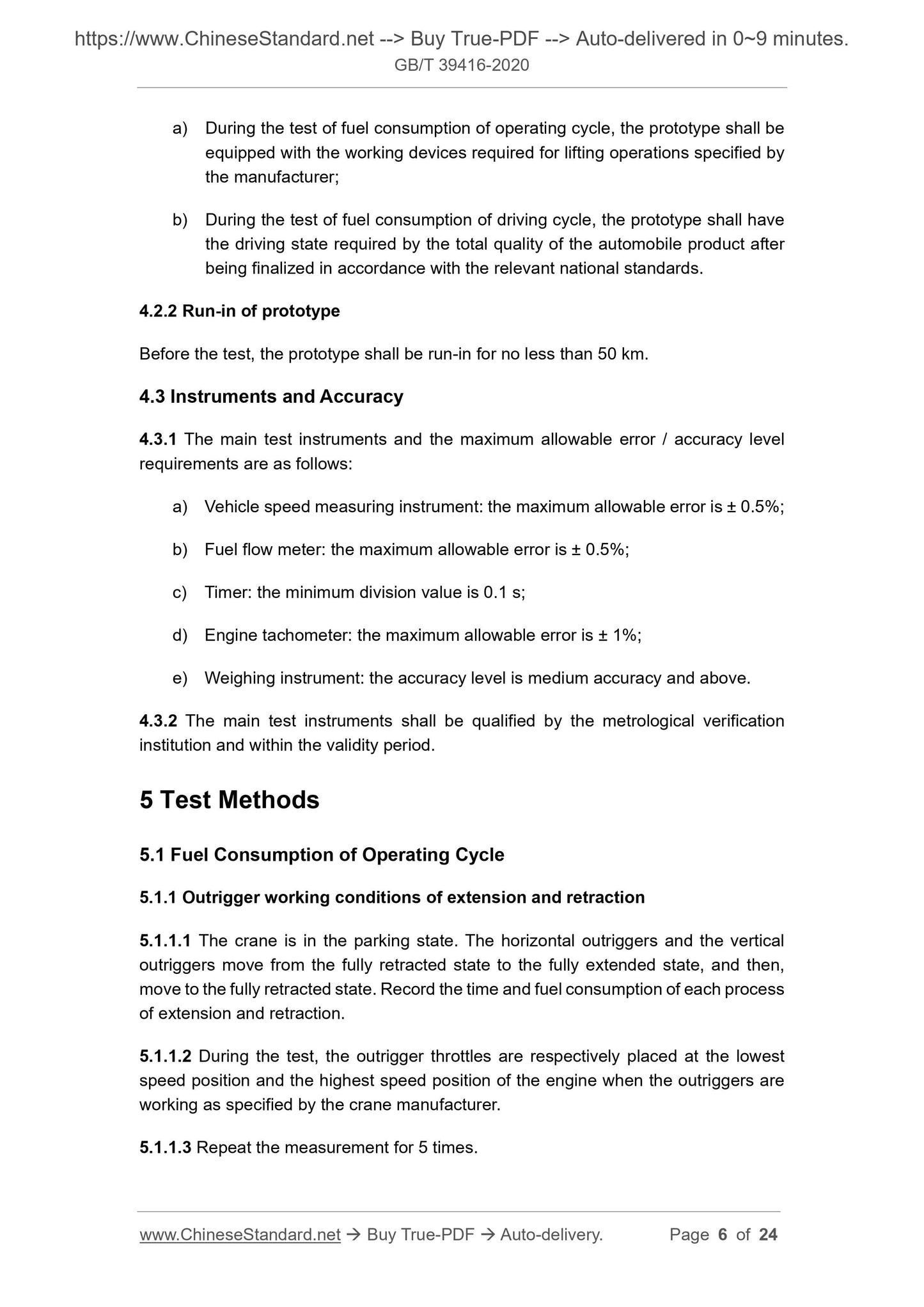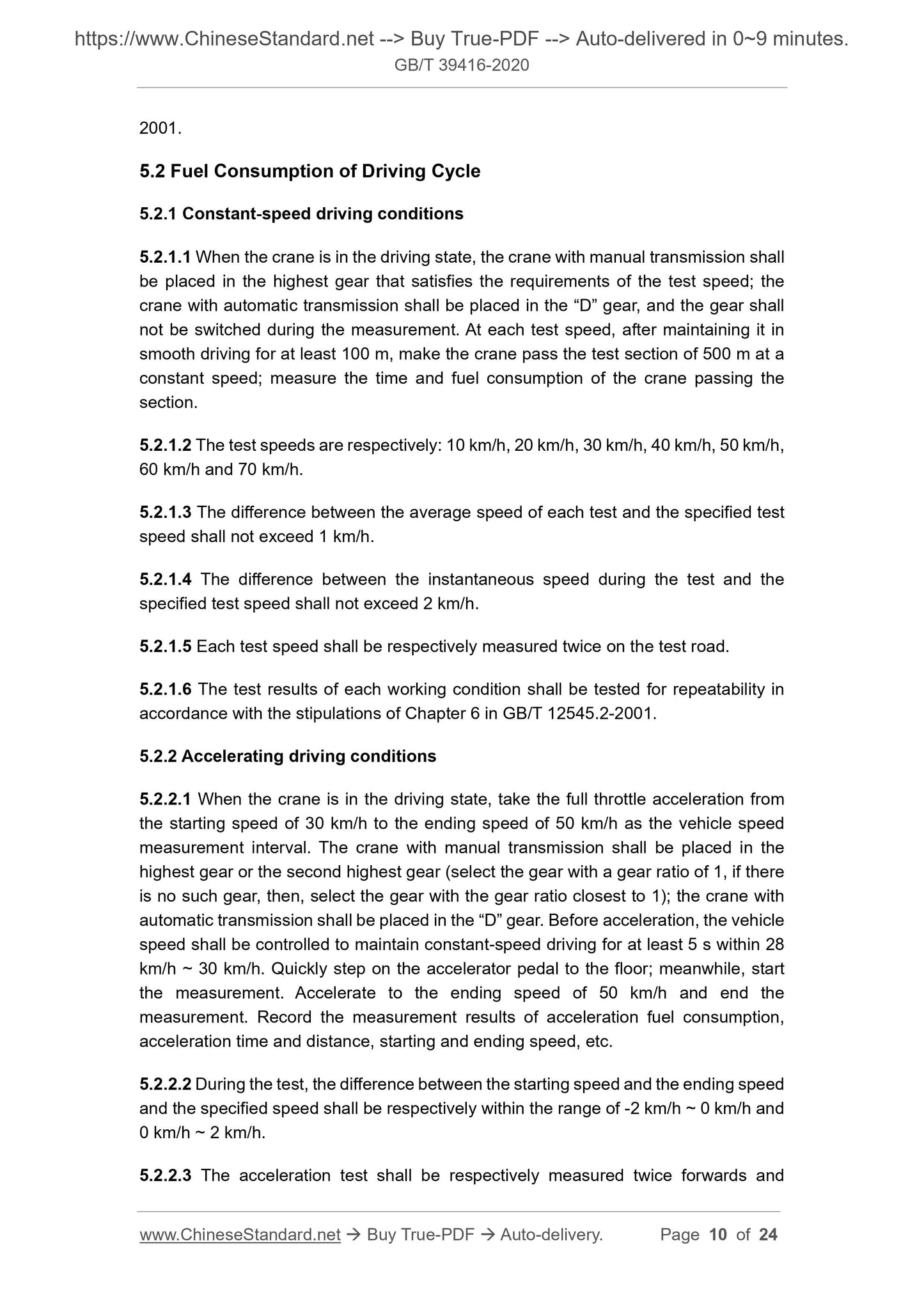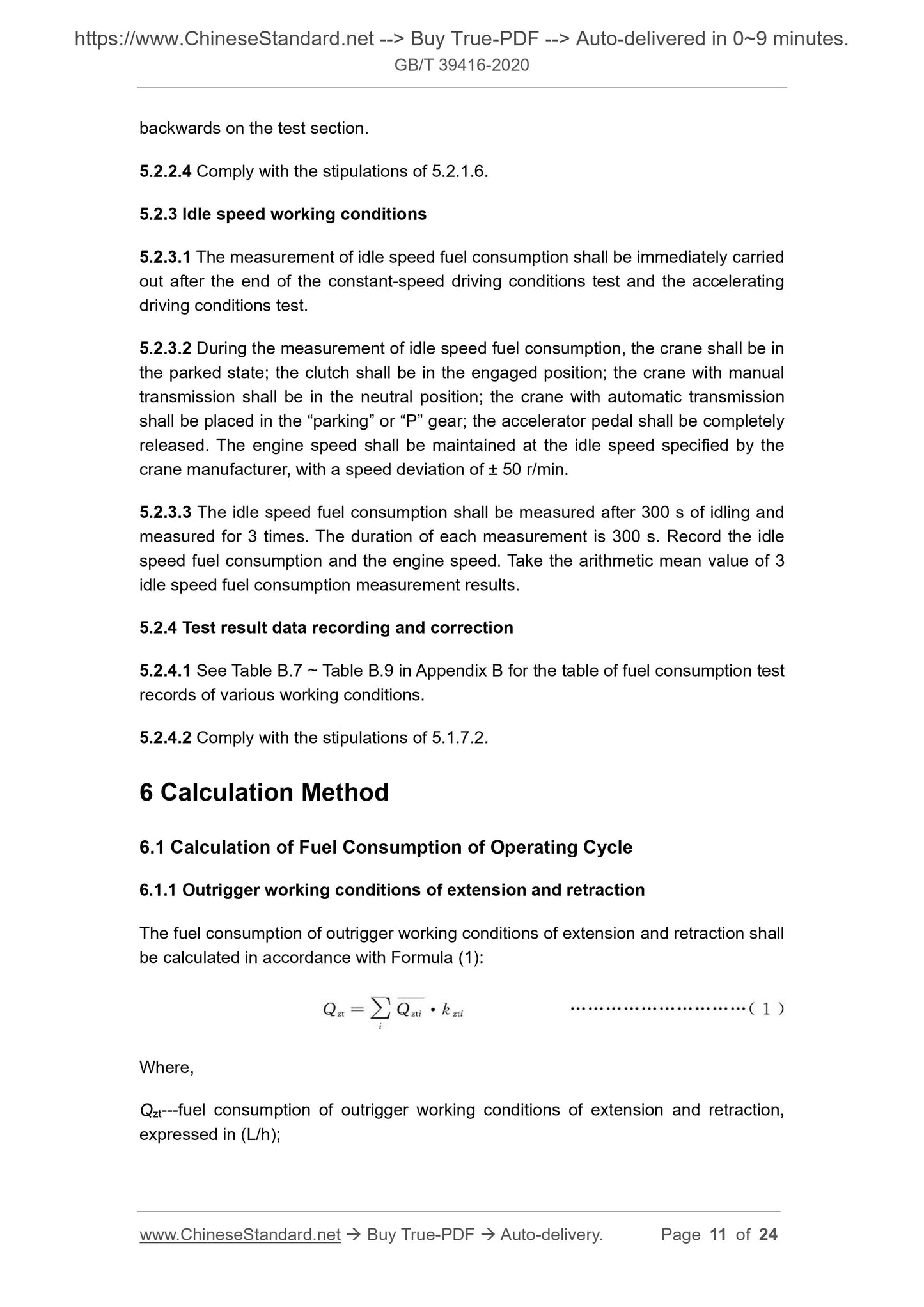1
/
of
6
www.ChineseStandard.us -- Field Test Asia Pte. Ltd.
GB/T 39416-2020 English PDF (GB/T39416-2020)
GB/T 39416-2020 English PDF (GB/T39416-2020)
Regular price
$325.00
Regular price
Sale price
$325.00
Unit price
/
per
Shipping calculated at checkout.
Couldn't load pickup availability
GB/T 39416-2020: Test Methods of Fuel Consumption for Truck Crane
Delivery: 9 seconds. Download (& Email) true-PDF + Invoice.
Get Quotation: Click GB/T 39416-2020 (Self-service in 1-minute)
Historical versions (Master-website): GB/T 39416-2020
Preview True-PDF (Reload/Scroll-down if blank)
GB/T 39416-2020
GB
NATIONAL STANDARD OF THE
PEOPLE’S REPUBLIC OF CHINA
ICS 53.020.20
J 80
Test Methods of Fuel Consumption for Truck Crane
ISSUED ON: NOVEMBER 19, 2020
IMPLEMENTED ON: JUNE 1, 2021
Issued by: State Administration for Market Regulation;
Standardization Administration of the People’s Republic of
China.
Table of Contents
Foreword ... 3
1 Scope ... 4
2 Normative References ... 4
3 Terms and Definitions ... 4
4 Test Preparation ... 5
4.1 Test Conditions ... 5
4.2 Test Prototype ... 5
4.3 Instruments and Accuracy ... 6
5 Test Methods ... 6
5.1 Fuel Consumption of Operating Cycle ... 6
5.2 Fuel Consumption of Driving Cycle ... 10
6 Calculation Method ... 11
6.1 Calculation of Fuel Consumption of Operating Cycle ... 11
6.2 Calculation of Fuel Consumption of Driving Cycle ... 16
Appendix A (informative) A Checklist of Fuel Consumption Test Prototype for
Crane ... 17
Appendix B (informative) Fuel Consumption Test Data Record ... 18
Test Methods of Fuel Consumption for Truck Crane
1 Scope
This Standard specifies the test methods of fuel consumption for truck cranes
(including all-terrain cranes, hereinafter referred to as cranes).
This Standard is applicable to the test of fuel consumption for diesel-powered truck
cranes and all-terrain cranes.
2 Normative References
The following documents are indispensable to the application of this document. In
terms of references with a specified date, only versions with a specified date are
applicable to this document. In terms of references without a specified date, the latest
version (including all the modifications) is applicable to this document.
GB/T 6068-2008 Test Code for Truck Crane and Mobile Crane
GB/T 6974.1 Cranes - Vocabulary - Part 1: General
GB/T 12534-1990 Motor Vehicles - General Rules of Road Test Method
GB/T 12545.2-2001 Commercial Vehicle - Fuel Consumption Test Method
JT/T 719-2016 Limits and Measurement Methods of Fuel Consumption for Commercial
Vehicle for Cargos Transportation
3 Terms and Definitions
What is defined in GB/T 6068-2008 and GB/T 6974.1, and the following terms and
definitions are applicable to this document.
3.1 Mid-extend Boom
Mid-extend boom refers to 2/3 of the full extension of the main boom of a crane, or the
boom length closest to 2/3.
3.2 Fuel Consumption of Operating Cycle
Fuel consumption of operating cycle refers to the fuel consumed by a crane to
complete the operation of lifting within a unit time under the specified operating
conditions.
a) During the test of fuel consumption of operating cycle, the prototype shall be
equipped with the working devices required for lifting operations specified by
the manufacturer;
b) During the test of fuel consumption of driving cycle, the prototype shall have
the driving state required by the total quality of the automobile product after
being finalized in accordance with the relevant national standards.
4.2.2 Run-in of prototype
Before the test, the prototype shall be run-in for no less than 50 km.
4.3 Instruments and Accuracy
4.3.1 The main test instruments and the maximum allowable error / accuracy level
requirements are as follows:
a) Vehicle speed measuring instrument: the maximum allowable error is ± 0.5%;
b) Fuel flow meter: the maximum allowable error is ± 0.5%;
c) Timer: the minimum division value is 0.1 s;
d) Engine tachometer: the maximum allowable error is ± 1%;
e) Weighing instrument: the accuracy level is medium accuracy and above.
4.3.2 The main test instruments shall be qualified by the metrological verification
institution and within the validity period.
5 Test Methods
5.1 Fuel Consumption of Operating Cycle
5.1.1 Outrigger working conditions of extension and retraction
5.1.1.1 The crane is in the parking state. The horizontal outriggers and the vertical
outriggers move from the fully retracted state to the fully extended state, and then,
move to the fully retracted state. Record the time and fuel consumption of each process
of extension and retraction.
5.1.1.2 During the test, the outrigger throttles are respectively placed at the lowest
speed position and the highest speed position of the engine when the outriggers are
working as specified by the crane manufacturer.
5.1.1.3 Repeat the measurement for 5 times.
2001.
5.2 Fuel Consumption of Driving Cycle
5.2.1 Constant-speed driving conditions
5.2.1.1 When the crane is in the driving state, the crane with manual transmission shall
be placed in the highest gear that satisfies the requirements of the test speed; the
crane with automatic transmission shall be placed in the “D” gear, and the gear shall
not be switched during the measurement. At each test speed, after maintaining it in
smooth driving for at least 100 m, make the crane pass the test section of 500 m at a
constant speed; measure the time and fuel consumption of the crane passing the
section.
5.2.1.2 The test speeds are respectively: 10 km/h, 20 km/h, 30 km/h, 40 km/h, 50 km/h,
60 km/h and 70 km/h.
5.2.1.3 The difference between the average speed of each test and the specified test
speed shall not exceed 1 km/h.
5.2.1.4 The difference between the instantaneous speed during the test and the
specified test speed shall not exceed 2 km/h.
5.2.1.5 Each test speed shall be respectively measured twice on the test road.
5.2.1.6 The test results of each working condition shall be tested for repeatability in
accordance with the stipulations of Chapter 6 in GB/T 12545.2-2001.
5.2.2 Accelerating driving conditions
5.2.2.1 When the crane is in the driving state, take the full throttle acceleration from
the starting speed of 30 km/h to the ending speed of 50 km/h as the vehicle speed
measurement interval. The crane with manual transmission shall be placed in the
highest gear or the second highest gear (select the gear with a gear ratio of 1, if there
is no such gear, then, select the gear with the gear ratio closest to 1); the crane with
automatic transmission shall be placed in the “D” gear. Before acceleration, the vehicle
speed shall be controlled to maintain constant-speed driving for at least 5 s within 28
km/h ~ 30 km/h. Quickly step on the accelerator pedal to the floor; meanwhile, start
the measurement. Accelerate to the ending speed of 50 km/h and end the
measurement. Record the measurement results of acceleration fuel consumption,
acceleration time and distance, starting and ending speed, etc.
5.2.2.2 During the test, the difference between the starting speed and the ending speed
and the specified speed shall be respectively within the range of -2 km/h ~ 0 km/h and
0 km/h ~ 2 km/h.
5.2.2.3 The acceleration test shall be respectively measured twice forwards and
backwards on the test section.
5.2.2.4 Comply with the stipulations of 5.2.1.6.
5.2.3 Idle speed working conditions
5.2.3.1 The measurement of idle speed fuel consumption shall be immediately carried
out after the end of the constant-speed driving conditions test and the accelerating
driving conditions test.
5.2.3.2 During the measurement of idle speed fuel consumption, the crane shall be in
the parked state; the clutch shall be in the engaged position; the crane with manual
transmission shall be in the neutral position; the crane with automatic transmission
shall be placed in the “parking” or “P” gear; the accelerator pedal shall be completely
released. The engine speed shall be maintained at the idle speed specified by the
crane manufacturer, with a speed deviation of ± 50 r/min.
5.2.3.3 The idle speed fuel consumption shall be measured after 300 s of idling and
measured for 3 times. The duration of each measurement is 300 s. Record the idle
speed fuel consumption and the engine speed. Take the arithmetic mean value of 3
idle speed fuel consumption measurement results.
5.2.4 Test result data recording and correction
5.2.4.1 See Table B.7 ~ Table B.9 in Appendix B for the table of fuel consumption test
records of various working conditions.
5.2.4.2 Comply with the stipulations of 5.1.7.2.
6 Calculation Method
6.1 Calculation of Fuel Consumption of Operating Cycle
6.1.1 Outrigger working conditions of extension and retraction
The fuel consumption of outrigger working conditions of extension and retraction shall
be calculated in accordance with Formula (1):
Where,
Qzt---fuel consumption of outrigger working conditions of extension and retraction,
expressed in (L/h);
GB/T 39416-2020
GB
NATIONAL STANDARD OF THE
PEOPLE’S REPUBLIC OF CHINA
ICS 53.020.20
J 80
Test Methods of Fuel Consumption for Truck Crane
ISSUED ON: NOVEMBER 19, 2020
IMPLEMENTED ON: JUNE 1, 2021
Issued by: State Administration for Market Regulation;
Standardization Administration of the People’s Republic of
China.
Table of Contents
Foreword ... 3
1 Scope ... 4
2 Normative References ... 4
3 Terms and Definitions ... 4
4 Test Preparation ... 5
4.1 Test Conditions ... 5
4.2 Test Prototype ... 5
4.3 Instruments and Accuracy ... 6
5 Test Methods ... 6
5.1 Fuel Consumption of Operating Cycle ... 6
5.2 Fuel Consumption of Driving Cycle ... 10
6 Calculation Method ... 11
6.1 Calculation of Fuel Consumption of Operating Cycle ... 11
6.2 Calculation of Fuel Consumption of Driving Cycle ... 16
Appendix A (informative) A Checklist of Fuel Consumption Test Prototype for
Crane ... 17
Appendix B (informative) Fuel Consumption Test Data Record ... 18
Test Methods of Fuel Consumption for Truck Crane
1 Scope
This Standard specifies the test methods of fuel consumption for truck cranes
(including all-terrain cranes, hereinafter referred to as cranes).
This Standard is applicable to the test of fuel consumption for diesel-powered truck
cranes and all-terrain cranes.
2 Normative References
The following documents are indispensable to the application of this document. In
terms of references with a specified date, only versions with a specified date are
applicable to this document. In terms of references without a specified date, the latest
version (including all the modifications) is applicable to this document.
GB/T 6068-2008 Test Code for Truck Crane and Mobile Crane
GB/T 6974.1 Cranes - Vocabulary - Part 1: General
GB/T 12534-1990 Motor Vehicles - General Rules of Road Test Method
GB/T 12545.2-2001 Commercial Vehicle - Fuel Consumption Test Method
JT/T 719-2016 Limits and Measurement Methods of Fuel Consumption for Commercial
Vehicle for Cargos Transportation
3 Terms and Definitions
What is defined in GB/T 6068-2008 and GB/T 6974.1, and the following terms and
definitions are applicable to this document.
3.1 Mid-extend Boom
Mid-extend boom refers to 2/3 of the full extension of the main boom of a crane, or the
boom length closest to 2/3.
3.2 Fuel Consumption of Operating Cycle
Fuel consumption of operating cycle refers to the fuel consumed by a crane to
complete the operation of lifting within a unit time under the specified operating
conditions.
a) During the test of fuel consumption of operating cycle, the prototype shall be
equipped with the working devices required for lifting operations specified by
the manufacturer;
b) During the test of fuel consumption of driving cycle, the prototype shall have
the driving state required by the total quality of the automobile product after
being finalized in accordance with the relevant national standards.
4.2.2 Run-in of prototype
Before the test, the prototype shall be run-in for no less than 50 km.
4.3 Instruments and Accuracy
4.3.1 The main test instruments and the maximum allowable error / accuracy level
requirements are as follows:
a) Vehicle speed measuring instrument: the maximum allowable error is ± 0.5%;
b) Fuel flow meter: the maximum allowable error is ± 0.5%;
c) Timer: the minimum division value is 0.1 s;
d) Engine tachometer: the maximum allowable error is ± 1%;
e) Weighing instrument: the accuracy level is medium accuracy and above.
4.3.2 The main test instruments shall be qualified by the metrological verification
institution and within the validity period.
5 Test Methods
5.1 Fuel Consumption of Operating Cycle
5.1.1 Outrigger working conditions of extension and retraction
5.1.1.1 The crane is in the parking state. The horizontal outriggers and the vertical
outriggers move from the fully retracted state to the fully extended state, and then,
move to the fully retracted state. Record the time and fuel consumption of each process
of extension and retraction.
5.1.1.2 During the test, the outrigger throttles are respectively placed at the lowest
speed position and the highest speed position of the engine when the outriggers are
working as specified by the crane manufacturer.
5.1.1.3 Repeat the measurement for 5 times.
2001.
5.2 Fuel Consumption of Driving Cycle
5.2.1 Constant-speed driving conditions
5.2.1.1 When the crane is in the driving state, the crane with manual transmission shall
be placed in the highest gear that satisfies the requirements of the test speed; the
crane with automatic transmission shall be placed in the “D” gear, and the gear shall
not be switched during the measurement. At each test speed, after maintaining it in
smooth driving for at least 100 m, make the crane pass the test section of 500 m at a
constant speed; measure the time and fuel consumption of the crane passing the
section.
5.2.1.2 The test speeds are respectively: 10 km/h, 20 km/h, 30 km/h, 40 km/h, 50 km/h,
60 km/h and 70 km/h.
5.2.1.3 The difference between the average speed of each test and the specified test
speed shall not exceed 1 km/h.
5.2.1.4 The difference between the instantaneous speed during the test and the
specified test speed shall not exceed 2 km/h.
5.2.1.5 Each test speed shall be respectively measured twice on the test road.
5.2.1.6 The test results of each working condition shall be tested for repeatability in
accordance with the st...
Delivery: 9 seconds. Download (& Email) true-PDF + Invoice.
Get Quotation: Click GB/T 39416-2020 (Self-service in 1-minute)
Historical versions (Master-website): GB/T 39416-2020
Preview True-PDF (Reload/Scroll-down if blank)
GB/T 39416-2020
GB
NATIONAL STANDARD OF THE
PEOPLE’S REPUBLIC OF CHINA
ICS 53.020.20
J 80
Test Methods of Fuel Consumption for Truck Crane
ISSUED ON: NOVEMBER 19, 2020
IMPLEMENTED ON: JUNE 1, 2021
Issued by: State Administration for Market Regulation;
Standardization Administration of the People’s Republic of
China.
Table of Contents
Foreword ... 3
1 Scope ... 4
2 Normative References ... 4
3 Terms and Definitions ... 4
4 Test Preparation ... 5
4.1 Test Conditions ... 5
4.2 Test Prototype ... 5
4.3 Instruments and Accuracy ... 6
5 Test Methods ... 6
5.1 Fuel Consumption of Operating Cycle ... 6
5.2 Fuel Consumption of Driving Cycle ... 10
6 Calculation Method ... 11
6.1 Calculation of Fuel Consumption of Operating Cycle ... 11
6.2 Calculation of Fuel Consumption of Driving Cycle ... 16
Appendix A (informative) A Checklist of Fuel Consumption Test Prototype for
Crane ... 17
Appendix B (informative) Fuel Consumption Test Data Record ... 18
Test Methods of Fuel Consumption for Truck Crane
1 Scope
This Standard specifies the test methods of fuel consumption for truck cranes
(including all-terrain cranes, hereinafter referred to as cranes).
This Standard is applicable to the test of fuel consumption for diesel-powered truck
cranes and all-terrain cranes.
2 Normative References
The following documents are indispensable to the application of this document. In
terms of references with a specified date, only versions with a specified date are
applicable to this document. In terms of references without a specified date, the latest
version (including all the modifications) is applicable to this document.
GB/T 6068-2008 Test Code for Truck Crane and Mobile Crane
GB/T 6974.1 Cranes - Vocabulary - Part 1: General
GB/T 12534-1990 Motor Vehicles - General Rules of Road Test Method
GB/T 12545.2-2001 Commercial Vehicle - Fuel Consumption Test Method
JT/T 719-2016 Limits and Measurement Methods of Fuel Consumption for Commercial
Vehicle for Cargos Transportation
3 Terms and Definitions
What is defined in GB/T 6068-2008 and GB/T 6974.1, and the following terms and
definitions are applicable to this document.
3.1 Mid-extend Boom
Mid-extend boom refers to 2/3 of the full extension of the main boom of a crane, or the
boom length closest to 2/3.
3.2 Fuel Consumption of Operating Cycle
Fuel consumption of operating cycle refers to the fuel consumed by a crane to
complete the operation of lifting within a unit time under the specified operating
conditions.
a) During the test of fuel consumption of operating cycle, the prototype shall be
equipped with the working devices required for lifting operations specified by
the manufacturer;
b) During the test of fuel consumption of driving cycle, the prototype shall have
the driving state required by the total quality of the automobile product after
being finalized in accordance with the relevant national standards.
4.2.2 Run-in of prototype
Before the test, the prototype shall be run-in for no less than 50 km.
4.3 Instruments and Accuracy
4.3.1 The main test instruments and the maximum allowable error / accuracy level
requirements are as follows:
a) Vehicle speed measuring instrument: the maximum allowable error is ± 0.5%;
b) Fuel flow meter: the maximum allowable error is ± 0.5%;
c) Timer: the minimum division value is 0.1 s;
d) Engine tachometer: the maximum allowable error is ± 1%;
e) Weighing instrument: the accuracy level is medium accuracy and above.
4.3.2 The main test instruments shall be qualified by the metrological verification
institution and within the validity period.
5 Test Methods
5.1 Fuel Consumption of Operating Cycle
5.1.1 Outrigger working conditions of extension and retraction
5.1.1.1 The crane is in the parking state. The horizontal outriggers and the vertical
outriggers move from the fully retracted state to the fully extended state, and then,
move to the fully retracted state. Record the time and fuel consumption of each process
of extension and retraction.
5.1.1.2 During the test, the outrigger throttles are respectively placed at the lowest
speed position and the highest speed position of the engine when the outriggers are
working as specified by the crane manufacturer.
5.1.1.3 Repeat the measurement for 5 times.
2001.
5.2 Fuel Consumption of Driving Cycle
5.2.1 Constant-speed driving conditions
5.2.1.1 When the crane is in the driving state, the crane with manual transmission shall
be placed in the highest gear that satisfies the requirements of the test speed; the
crane with automatic transmission shall be placed in the “D” gear, and the gear shall
not be switched during the measurement. At each test speed, after maintaining it in
smooth driving for at least 100 m, make the crane pass the test section of 500 m at a
constant speed; measure the time and fuel consumption of the crane passing the
section.
5.2.1.2 The test speeds are respectively: 10 km/h, 20 km/h, 30 km/h, 40 km/h, 50 km/h,
60 km/h and 70 km/h.
5.2.1.3 The difference between the average speed of each test and the specified test
speed shall not exceed 1 km/h.
5.2.1.4 The difference between the instantaneous speed during the test and the
specified test speed shall not exceed 2 km/h.
5.2.1.5 Each test speed shall be respectively measured twice on the test road.
5.2.1.6 The test results of each working condition shall be tested for repeatability in
accordance with the stipulations of Chapter 6 in GB/T 12545.2-2001.
5.2.2 Accelerating driving conditions
5.2.2.1 When the crane is in the driving state, take the full throttle acceleration from
the starting speed of 30 km/h to the ending speed of 50 km/h as the vehicle speed
measurement interval. The crane with manual transmission shall be placed in the
highest gear or the second highest gear (select the gear with a gear ratio of 1, if there
is no such gear, then, select the gear with the gear ratio closest to 1); the crane with
automatic transmission shall be placed in the “D” gear. Before acceleration, the vehicle
speed shall be controlled to maintain constant-speed driving for at least 5 s within 28
km/h ~ 30 km/h. Quickly step on the accelerator pedal to the floor; meanwhile, start
the measurement. Accelerate to the ending speed of 50 km/h and end the
measurement. Record the measurement results of acceleration fuel consumption,
acceleration time and distance, starting and ending speed, etc.
5.2.2.2 During the test, the difference between the starting speed and the ending speed
and the specified speed shall be respectively within the range of -2 km/h ~ 0 km/h and
0 km/h ~ 2 km/h.
5.2.2.3 The acceleration test shall be respectively measured twice forwards and
backwards on the test section.
5.2.2.4 Comply with the stipulations of 5.2.1.6.
5.2.3 Idle speed working conditions
5.2.3.1 The measurement of idle speed fuel consumption shall be immediately carried
out after the end of the constant-speed driving conditions test and the accelerating
driving conditions test.
5.2.3.2 During the measurement of idle speed fuel consumption, the crane shall be in
the parked state; the clutch shall be in the engaged position; the crane with manual
transmission shall be in the neutral position; the crane with automatic transmission
shall be placed in the “parking” or “P” gear; the accelerator pedal shall be completely
released. The engine speed shall be maintained at the idle speed specified by the
crane manufacturer, with a speed deviation of ± 50 r/min.
5.2.3.3 The idle speed fuel consumption shall be measured after 300 s of idling and
measured for 3 times. The duration of each measurement is 300 s. Record the idle
speed fuel consumption and the engine speed. Take the arithmetic mean value of 3
idle speed fuel consumption measurement results.
5.2.4 Test result data recording and correction
5.2.4.1 See Table B.7 ~ Table B.9 in Appendix B for the table of fuel consumption test
records of various working conditions.
5.2.4.2 Comply with the stipulations of 5.1.7.2.
6 Calculation Method
6.1 Calculation of Fuel Consumption of Operating Cycle
6.1.1 Outrigger working conditions of extension and retraction
The fuel consumption of outrigger working conditions of extension and retraction shall
be calculated in accordance with Formula (1):
Where,
Qzt---fuel consumption of outrigger working conditions of extension and retraction,
expressed in (L/h);
GB/T 39416-2020
GB
NATIONAL STANDARD OF THE
PEOPLE’S REPUBLIC OF CHINA
ICS 53.020.20
J 80
Test Methods of Fuel Consumption for Truck Crane
ISSUED ON: NOVEMBER 19, 2020
IMPLEMENTED ON: JUNE 1, 2021
Issued by: State Administration for Market Regulation;
Standardization Administration of the People’s Republic of
China.
Table of Contents
Foreword ... 3
1 Scope ... 4
2 Normative References ... 4
3 Terms and Definitions ... 4
4 Test Preparation ... 5
4.1 Test Conditions ... 5
4.2 Test Prototype ... 5
4.3 Instruments and Accuracy ... 6
5 Test Methods ... 6
5.1 Fuel Consumption of Operating Cycle ... 6
5.2 Fuel Consumption of Driving Cycle ... 10
6 Calculation Method ... 11
6.1 Calculation of Fuel Consumption of Operating Cycle ... 11
6.2 Calculation of Fuel Consumption of Driving Cycle ... 16
Appendix A (informative) A Checklist of Fuel Consumption Test Prototype for
Crane ... 17
Appendix B (informative) Fuel Consumption Test Data Record ... 18
Test Methods of Fuel Consumption for Truck Crane
1 Scope
This Standard specifies the test methods of fuel consumption for truck cranes
(including all-terrain cranes, hereinafter referred to as cranes).
This Standard is applicable to the test of fuel consumption for diesel-powered truck
cranes and all-terrain cranes.
2 Normative References
The following documents are indispensable to the application of this document. In
terms of references with a specified date, only versions with a specified date are
applicable to this document. In terms of references without a specified date, the latest
version (including all the modifications) is applicable to this document.
GB/T 6068-2008 Test Code for Truck Crane and Mobile Crane
GB/T 6974.1 Cranes - Vocabulary - Part 1: General
GB/T 12534-1990 Motor Vehicles - General Rules of Road Test Method
GB/T 12545.2-2001 Commercial Vehicle - Fuel Consumption Test Method
JT/T 719-2016 Limits and Measurement Methods of Fuel Consumption for Commercial
Vehicle for Cargos Transportation
3 Terms and Definitions
What is defined in GB/T 6068-2008 and GB/T 6974.1, and the following terms and
definitions are applicable to this document.
3.1 Mid-extend Boom
Mid-extend boom refers to 2/3 of the full extension of the main boom of a crane, or the
boom length closest to 2/3.
3.2 Fuel Consumption of Operating Cycle
Fuel consumption of operating cycle refers to the fuel consumed by a crane to
complete the operation of lifting within a unit time under the specified operating
conditions.
a) During the test of fuel consumption of operating cycle, the prototype shall be
equipped with the working devices required for lifting operations specified by
the manufacturer;
b) During the test of fuel consumption of driving cycle, the prototype shall have
the driving state required by the total quality of the automobile product after
being finalized in accordance with the relevant national standards.
4.2.2 Run-in of prototype
Before the test, the prototype shall be run-in for no less than 50 km.
4.3 Instruments and Accuracy
4.3.1 The main test instruments and the maximum allowable error / accuracy level
requirements are as follows:
a) Vehicle speed measuring instrument: the maximum allowable error is ± 0.5%;
b) Fuel flow meter: the maximum allowable error is ± 0.5%;
c) Timer: the minimum division value is 0.1 s;
d) Engine tachometer: the maximum allowable error is ± 1%;
e) Weighing instrument: the accuracy level is medium accuracy and above.
4.3.2 The main test instruments shall be qualified by the metrological verification
institution and within the validity period.
5 Test Methods
5.1 Fuel Consumption of Operating Cycle
5.1.1 Outrigger working conditions of extension and retraction
5.1.1.1 The crane is in the parking state. The horizontal outriggers and the vertical
outriggers move from the fully retracted state to the fully extended state, and then,
move to the fully retracted state. Record the time and fuel consumption of each process
of extension and retraction.
5.1.1.2 During the test, the outrigger throttles are respectively placed at the lowest
speed position and the highest speed position of the engine when the outriggers are
working as specified by the crane manufacturer.
5.1.1.3 Repeat the measurement for 5 times.
2001.
5.2 Fuel Consumption of Driving Cycle
5.2.1 Constant-speed driving conditions
5.2.1.1 When the crane is in the driving state, the crane with manual transmission shall
be placed in the highest gear that satisfies the requirements of the test speed; the
crane with automatic transmission shall be placed in the “D” gear, and the gear shall
not be switched during the measurement. At each test speed, after maintaining it in
smooth driving for at least 100 m, make the crane pass the test section of 500 m at a
constant speed; measure the time and fuel consumption of the crane passing the
section.
5.2.1.2 The test speeds are respectively: 10 km/h, 20 km/h, 30 km/h, 40 km/h, 50 km/h,
60 km/h and 70 km/h.
5.2.1.3 The difference between the average speed of each test and the specified test
speed shall not exceed 1 km/h.
5.2.1.4 The difference between the instantaneous speed during the test and the
specified test speed shall not exceed 2 km/h.
5.2.1.5 Each test speed shall be respectively measured twice on the test road.
5.2.1.6 The test results of each working condition shall be tested for repeatability in
accordance with the st...
Share
